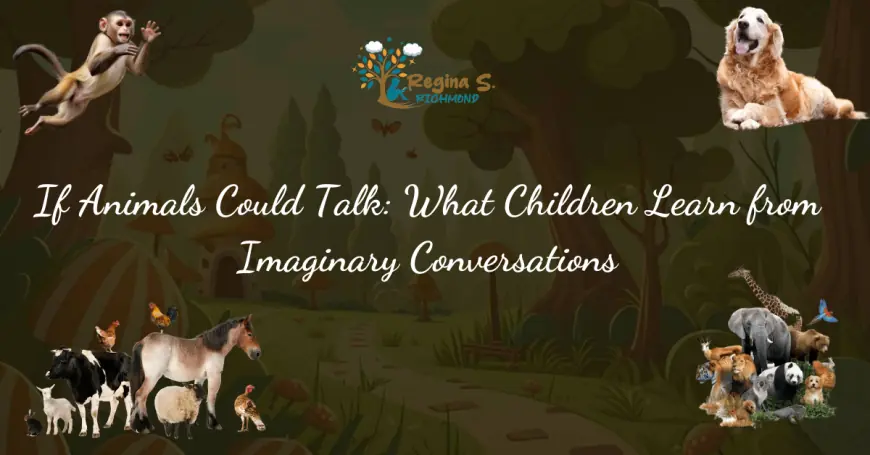If Animals Could Talk: What Children Learn from Imaginary Conversations
Ask almost any child if they’ve ever imagined talking to a dog, horse, or bird, and you’ll get a knowing smile, or maybe a full-fledged story. Whether it’s a whispered secret to a family pet or a made-up conversation with a favorite stuffed animal, kids seem to know that animals have something to say.
And in the world of children’s literature, they often do.
Of course, this is another one of those stories in the long line that includes Charlotte's Web and even recent ones like The Adventures at Red Oak Farm - Stacy and Cowboy by Regina S. Richmond, all of which have brought us animals that are not only cute and clever but meaningful as well. And such stories offer a very soft, accessible gateway to their readers, therefore educating very young hearts about emotions and relationships in life. And while doing all this, it teaches something very precious: emotional intelligence.
Let’s take a closer look at why these imaginary conversations matter so much and what children are really learning when animals start to speak.
1. Animal Dialogue Makes Emotions Safe to Explore
Kids don’t always have the vocabulary to explain what they’re feeling. Sadness, anxiety, guilt, jealousy, those are big emotions for small hearts. But when those feelings are voiced by an animal, something shifts. It becomes less intimidating. Less personal. And much easier to understand.
In The Adventures at Red Oak Farm, Stacy is grieving the loss of her parents and adjusting to a completely new life on her grandparents’ farm. It’s a heavy emotional load for a six-year-old. But her interactions with animals, especially Rex, the wise old dog, and Cowboy, the puppy she bonds with, offer her a way to process that grief without having to explain it outright.
Rex doesn’t lecture. He listens. Cowboy doesn’t ask for answers. He asks for love. And slowly, through these quiet conversations, Stacy begins to heal, and readers are invited to heal alongside her.
When children see emotions played out by animals, it gives them the freedom to ask questions they might not ask otherwise. “Why is the horse afraid?” can lead to “Have you ever felt afraid?” That’s the beginning of emotional literacy.
2. Imaginary Conversations Teach Empathy Without Effort
One of the core lessons in emotional intelligence is empathy: the ability to understand and share the feelings of others. It’s a skill that takes time to build, and stories where animals speak make it feel natural.
Why? Because animals, in fiction, are often given very human traits, but without the baggage of human complexity. A scared puppy is easy to relate to. A stubborn pony who just wants to be left alone? Most kids have felt that way, too. These animal characters express big feelings with honesty and clarity.
In Red Oak Farm, each animal has a distinct voice and personality. Cowboy is full of energy and longing. Rex is calm, thoughtful, and slightly world-weary. Even the cows have opinions. These personalities help kids practice “seeing” from another point of view, even if it’s a four-legged one.
And once they’ve practiced empathy through an animal character, it’s easier to transfer that understanding to classmates, siblings, and friends.
3. Talking Animals Give Kids a Safe Place to Ask “What If?”
“What if I had to move away from home?”
“What if my best friend got mad at me?”
“What if I wasn’t sure anyone loved me?”
These questions are hard to ask out loud. But in stories, they’re often asked and answered through animal dialogue, sometimes directly, sometimes between the lines.
In The Adventures at Red Oak Farm, Stacy wonders, through her interactions with the animals, about trust, belonging, and purpose. When Cowboy says, “I’m your puppy. I don’t want anyone else to own me,” he’s not just talking about ownership; he’s talking about attachment, loyalty, and identity.
Children absorb these moments in ways adults might not realize. The questions linger. And later, in quiet moments, they return, this time in the child’s own voice.
That’s the gift of imaginary conversations. They let kids explore hard questions safely, wrapped in a story that comforts even as it challenges.
4. They Help Normalize a Range of Emotions
One of the most beautiful things about animal dialogue in literature is that it normalizes a wide range of emotional experiences. Not every animal is happy-go-lucky. Some are grumpy. Some are nervous. Some are sad or shy or deeply uncertain.
And that’s a good thing.
Because when kids read about animals who feel those same things, it gives them permission to feel those things too. Without shame. Without fear.
In Red Oak Farm, Stacy doesn’t just connect with the animals emotionally, she mirrors them. When Cowboy is timid, she’s gentle. When Rex is worried, she comforts him. And in doing so, she learns how to do the same for herself.
This kind of storytelling teaches self-regulation and emotional validation in a subtle, natural way. It says: “It’s okay to feel. And it’s okay to care for others when they feel too.”
5. Animal Conversations Foster Imagination and Emotional Insight
Of course, there’s another reason kids love talking animals: it’s fun. There’s magic in imagining that the family cat is secretly a philosopher, or that the school hamster has a running commentary on classroom drama.
But even as they giggle or daydream, children are building emotional insights. They’re practicing dialogue, exploring motivations, and learning how to interpret emotional cues.
It’s pretend, but it’s also practice.
When children imagine what their dog would say if he could talk, they’re developing:
- Perspective-taking
- Emotional naming
- Non-verbal interpretation
- Compassionate reasoning
All of those are essential components of emotional intelligence. And all of them are cultivated through stories like The Adventures at Red Oak Farm, where the animals aren’t just background, they’re emotional guides.
Final Thoughts
We live in a world where emotional awareness is more important than ever. Kids face big feelings at earlier ages, and many are navigating challenges we never dreamed of at their age. Stories that offer tools to understand and express those feelings aren’t just nice, they’re necessary.
Talking animals, in the hands of the right author, are more than fantasy. They’re mirrors. They’re teachers. They’re safe companions on the journey toward emotional growth.
Regina S. Richmond’s The Adventures at Red Oak Farm – Stacy and Cowboy is a gentle reminder that you don’t have to shout to be heard, and that sometimes, the most important lessons come from a dog with kind eyes and a lot to say.
So the next time your child asks, “Do you think our cat knows what I’m thinking?” don’t laugh it off. Ask what the cat might say back. Let the conversation unfold.
Because in that moment, they’re not just playing.
They’re learning how to understand the world and themselves.

What's Your Reaction?
 Like
0
Like
0
 Dislike
0
Dislike
0
 Love
0
Love
0
 Funny
0
Funny
0
 Angry
0
Angry
0
 Sad
0
Sad
0
 Wow
0
Wow
0
















































